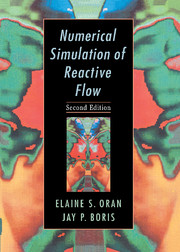Book contents
- Frontmatter
- Contents
- Prologue
- 1 An Overview of Numerical Simulation
- 2 The Reactive-Flow Modeling Problem
- 3 Models and Simulation
- 4 Some General Numerical Considerations
- 5 Ordinary Differential Equations: Reaction Mechanisms and Other Local Phenomena
- 6 Representations, Resolution, and Grids
- 7 Diffusive Transport Processes
- 8 Computational Fluid Dynamics: Continuity Equations
- 9 Computational Fluid Dynamics: Using More Flow Physics
- 10 Boundaries, Interfaces, and Implicit Algorithms
- 11 Coupling Models of Reactive-Flow Processes
- 12 Turbulent Reactive Flows
- 13 Radiation Transport and Reactive Flows
- Index
11 - Coupling Models of Reactive-Flow Processes
Published online by Cambridge University Press: 09 October 2009
- Frontmatter
- Contents
- Prologue
- 1 An Overview of Numerical Simulation
- 2 The Reactive-Flow Modeling Problem
- 3 Models and Simulation
- 4 Some General Numerical Considerations
- 5 Ordinary Differential Equations: Reaction Mechanisms and Other Local Phenomena
- 6 Representations, Resolution, and Grids
- 7 Diffusive Transport Processes
- 8 Computational Fluid Dynamics: Continuity Equations
- 9 Computational Fluid Dynamics: Using More Flow Physics
- 10 Boundaries, Interfaces, and Implicit Algorithms
- 11 Coupling Models of Reactive-Flow Processes
- 12 Turbulent Reactive Flows
- 13 Radiation Transport and Reactive Flows
- Index
Summary
The previous chapters described techniques for solving the equations used to model different physical terms in the reactive-flow equations using algorithms that seemed most appropriate for each particular type of term. In each case, we identified those methods that would be best to combine and use in a reactive-flow program. This chapter delves into a fundamental issue in numerical simulations of reactive-flows: how to put all of this together in one computer model. How do we couple these separate algorithms in a way that is accurate enough and produces efficient yet flexible programs?
In a reacting flow, the different physical processes occur simultaneously, not separately or sequentially. For example, any temperature increase due to chemical reactions causes a local expansion of the gas at the same time the reactions are occurring, not some finite time later. There are at least two computational problems that result from this. First, the simulations must reproduce the correct physics of the interactions, even if it is not contained in the separate processes treated sequentially. Second, the coupling among parts of the equations representing different physical processes can be mathematically stiff. This is stiffness in the same sense discussed in Chapter 5, where some of the equations representing changes in densities of different reacting species may be mathematically stiff. The problem of coupling different processes becomes very serious if the system is characterized by multiple time and space scales.
The last section in Chapter 4, Section 4–6, gave a brief introduction to the coupling problem and highlighted the two main approaches, global-implicit methods and timestepsplitting methods.
- Type
- Chapter
- Information
- Numerical Simulation of Reactive Flow , pp. 405 - 442Publisher: Cambridge University PressPrint publication year: 2000



